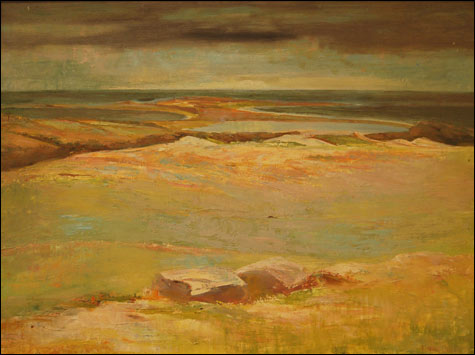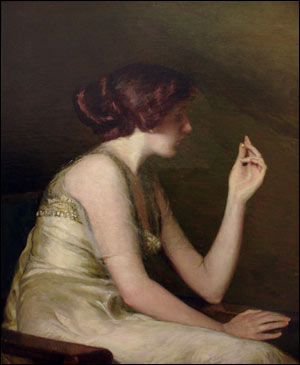
A STANDOUT Carry's Looking Toward Sachuest Point. |
Rhode Island is one of the preeminent places for art-making in America, thanks in great part to the Rhode Island School of Design, but what would it be without its pioneering women? RISD itself was founded by women in 1877, and led by Helen Adelina Rowe Metcalf and then her daughter Eliza Greene Metcalf Radeke for its first five decades. And "Remembering the Ladies: Women and the Art Association of Newport" at the Newport Art Museum (76 Bellevue Avenue, through October 16) reminds us that the museum was founded as the Art Association of Newport in 1912 by a group of four men and three women, led by Maud Howe Elliott.

A CLOSER LOOK Lilla Cabot Perry's The Pearl. |
Elliott was the daughter of Julia Ward Howe, the abolitionist and author of "The Battle Hymn of the Republic," and Dr. Samuel Gridley Howe, the first director of the Perkins School for the Blind in Boston. She was a suffragette and, with her sisters, author of a 1915 biography of her mother that won a Pulitzer Prize. And, as Newport Museum curator Nancy Whipple Grinnell notes, Elliott's "belief that art was a civilizing influence informed her lifelong crusade to 'cultivate and promote artistic endeavor and interest in the arts.' "
"Remembering the Ladies" surveys the art made by the women of the association. More than half its 142 charter members were women and, from its first exhibitions, women artists were featured a bit under half the time. This show begins in the late 19th century Gilded Age, with American artists still looking to France for inspiration. A particular influence is the gold-hued realism of late French Academic style of American painter William Morris Hunt, who taught in Newport in the late 19th century and whose former Newport studio became the first home of the Art Association.
Eleanor Richards Price's small, precise 1905 painting of trees reflected in a still lake evokes the French Academy, while French Impressionism influences a circa 1925 landscape looking down verdant hills to sailing ships on the bright blue-pink horizon by Helena Sturtevant, one of the association's founders and the school's first director. Gertrude Vanderbilt Whitney, who founded the Whitney Museum of American Art in New York in 1931, reflects the influence of her French teacher Rodin in the purposefully rough surface of her 1919 bronze The Engineer, depicting a laborer stooped over digging.
The second half of the exhibit shows the Art Association women imbibing 20th-century modernism. Catharine Morris Wright's flinty, spare 1936 watercolor rendering of the white Beaver Tail Light rivals the lighthouses Edward Hopper painted in Maine and Cape Cod in the '20s and '30s. Florence Leif's expressionist 1959 gouache of chunky, stylized Maine forest and shore recalls Marsden Hartley's late paintings of Maine.